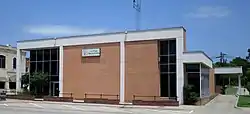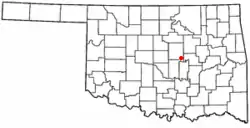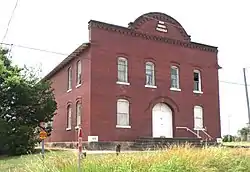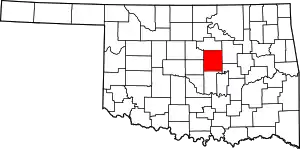Prague, Oklahoma
Prague /ˈpreɪɡ/[6] is a city in southeastern Lincoln County, Oklahoma, United States. The population was 2,386 at the 2010 census, an 11.6 percent increase from the figure of 2,138 in 2000.[7] Czech immigrants founded the city, and named it for the present-day capital of the Czech Republic with an altered pronunciation of the name.
Prague, Oklahoma | |
|---|---|
 Prague Municipal Building | |
 Flag | |
| Motto(s): A small town with a big heart.[1] | |
 Location of Prague, Oklahoma | |
| Coordinates: 35°29′10″N 96°41′16″W | |
| Country | United States |
| State | Oklahoma |
| County | Lincoln |
| Area | |
| • Total | 3.35 sq mi (8.68 km2) |
| • Land | 3.00 sq mi (7.76 km2) |
| • Water | 0.35 sq mi (0.92 km2) |
| Elevation | 1,010 ft (308 m) |
| Population (2010) | |
| • Total | 2,386 |
| • Estimate (2019)[3] | 2,367 |
| • Density | 789.79/sq mi (304.89/km2) |
| Time zone | UTC−6 (Central (CST)) |
| • Summer (DST) | UTC−5 (CDT) |
| ZIP Code | 74864 |
| Area code(s) | 405 |
| FIPS code | 40-60500[4] |
| GNIS feature ID | 1096887[5] |
| Website | www |
History
Czech immigrants settled Prague, after the opening of the Sac and Fox Reservation by a land run on September 22, 1891. Eva Barta owned the land, and named the new town "Prague" for the Czech capital in Europe, then part of Austria-Hungary. The town incorporated in 1902.[8]
On March 27, 1943, the film Hangmen Also Die! had its world premiere in Prague in an event which featured Adolf Hitler, Hirohito and Mussolini being hanged in effigy on Main Street. The town of Prague was apparently chosen because the movie is loosely based on the 1942 assassination of Reinhard Heydrich, the Nazi Reich Protector of the German-occupied city of Prague, now in the Czech Republic. After the premiere, the film opened nationwide in the first days of April, beginning with 20 key cities.
On May 24, 1952, a head-on automobile collision seriously injured Indian mystic Meher Baba near Prague.[9]
An F5 tornado tore through Prague on May 5, 1960.
On November 5, 2011 a series of earthquakes struck near Prague, the first one a magnitude 4.7 at 2:15 a.m. CST, followed by a series of aftershocks, and then a second quake of magnitude 5.7 at 10:53 p.m. CST, the strongest recorded in Oklahoma history until a 5.8-magnitude earthquake occurred on September 3, 2016. This continued on November 7, 2011 when another 4.7 hit at 8:45 p.m., just five miles northwest of Prague.
Geography
Prague is located at 35°29′10″N 96°41′16″W (35.486092, -96.687792).[10]
According to the United States Census Bureau, the city has a total area of 1.8 square miles (4.7 km2), all land.
Demographics
| Historical population | |||
|---|---|---|---|
| Census | Pop. | %± | |
| 1910 | 1,025 | — | |
| 1920 | 1,127 | 10.0% | |
| 1930 | 1,299 | 15.3% | |
| 1940 | 1,422 | 9.5% | |
| 1950 | 1,546 | 8.7% | |
| 1960 | 1,545 | −0.1% | |
| 1970 | 1,802 | 16.6% | |
| 1980 | 2,208 | 22.5% | |
| 1990 | 2,308 | 4.5% | |
| 2000 | 2,138 | −7.4% | |
| 2010 | 2,386 | 11.6% | |
| 2019 (est.) | 2,367 | [3] | −0.8% |
| U.S. Decennial Census[11] | |||
As of the census[4] of 2000, there were 2,138 people, 864 households, and 567 families residing in the city. The population density was 1,211.6 people per square mile (469.0/km2). There were 1,021 housing units at an average density of 578.6 per square mile (224.0/km2). The racial makeup of the city was 83.07% White, 3.70% African American, 9.92% Native American, 0.33% Asian, 0.09% from other races, and 2.90% from two or more races. Hispanic or Latino of any race were 1.12% of the population.
There were 864 households, out of which 31.9% had children under the age of 18 living with them, 49.9% were married couples living together, 11.6% had a female householder with no husband present, and 34.3% were non-families. 30.9% of all households were made up of individuals, and 17.0% had someone living alone who was 65 years of age or older. The average household size was 2.34 and the average family size was 2.91.
In the city, the population was spread out, with 25.3% under the age of 18, 7.8% from 18 to 24, 27.6% from 25 to 44, 19.9% from 45 to 64, and 19.4% who were 65 years of age or older. The median age was 39 years. For every 100 females, there were 84.2 males. For every 100 females age 18 and over, there were 81.9 males.
The median income for a household in the city was $26,779, and the median income for a family was $32,137. Males had a median income of $24,083 versus $19,438 for females. The per capita income for the city was $14,381. About 11.3% of families and 17.0% of the population were below the poverty line, including 17.4% of those under age 18 and 15.9% of those age 65 or over.
Newspapers

The Shawnee News Star and the Prague Times Herald , provide news coverage of Prague.
The Oklahomski Noviny was a Czech-language newspaper printed in Prague in the 20th Century.[8]
Education
The Prague Public Schools serve approximately 1000 students.
Economy
Agriculture, with corn as the primary crop, initially drove Prague's economy. This was still true at the beginning of the 21st century. Industry and commerce began to contribute later.[8]
Government
Prague has a council-manager form of city government.[8]
Transportation
Prague is at the intersection of U.S. Routes 377 and 62, and is approximately 10 minutes north of Interstate 40.[12]
The Prague-owned Prague Municipal Airport (FAA Identifier—O47) is two miles west of town, and features a 3600’ asphalt runway.[13]
Culture
On the first Saturday of May each year there is a 'Kolache Festival'. It celebrates the Czech culture brought from the 'old country.' One can learn more at the Prague Historical Museum on the town's main street, Jim Thorpe Boulevard, which is named for the town's most famous son, the Olympic athlete Jim Thorpe.
Reflecting its Czech Catholic heritage, Prague is also the home of a Papal-authorized copy of the Infant Jesus of Prague, known as the National Shrine of the Infant Jesus, which draws numerous visitors each year.[14]
Notable people
- Kyle Denney, former major league baseball player.
- Walter E. Fountain, United States Army Brigadier General, Assistant Adjutant General of the Oklahoma Army National Guard, acting Deputy Director of the Army National Guard
- Richard James, lawyer and legislator
- Jim Thorpe, Olympic gold medalist, considered one of the most versatile athletes in modern sports.
- Olinka Hrdy (1902-1987), artist[15]
- Orville Edwin Langley (1908-1973), U.S. District Judge for Eastern Oklahoma (1965-1973). Born in Prague, Oklahoma.
NRHP sites
The following sites in Prague are listed on the National Register of Historic Places:
- Prague City Hall and Jail
- ZCBJ Lodge No. 46, also known as Bohemian Hall
References
- "Home Page". City of Prague. Retrieved July 23, 2020.
- "2019 U.S. Gazetteer Files". United States Census Bureau. Retrieved July 28, 2020.
- "Population and Housing Unit Estimates". United States Census Bureau. May 24, 2020. Retrieved May 27, 2020.
- "U.S. Census website". United States Census Bureau. Retrieved 2008-01-31.
- "US Board on Geographic Names". United States Geological Survey. 2007-10-25. Retrieved 2008-01-31.
- "Why Lima, Ohio, and Lima, Peru, Don't Have the Same Pronunciation". All Things Considered. National Public Radio. 21 March 2019. Retrieved 29 May 2019.
- CensusViewer:Prague, Oklahoma Population. Retrieved January 19, 2014.
- Pritchett, Roger. Encyclopedia of Oklahoma History and Culture. "Prague." Retrieved March 6, 2015.
- Kalchuri, Bhau (1986). Meher Prabhu: Lord Meher, The Biography of the Avatar of the Age, Meher Baba. Manifestation.
- "US Gazetteer files: 2010, 2000, and 1990". United States Census Bureau. 2011-02-12. Retrieved 2011-04-23.
- "Census of Population and Housing". Census.gov. Retrieved June 4, 2015.
- "Prague, Oklahoma". Google Maps. Retrieved July 23, 2020.
- "Prague Municipal Airport". AirNav. Retrieved July 23, 2020.
- "The National Shrine of the Infant Jesus of Prague, Oklahoma". The National Shrine of the Infant Jesus of Prague, Oklahoma. 2007. Retrieved 9 February 2010.
- "Lost Olinka | This Land Press - Made by You and Me". thislandpress.com. Retrieved 2016-06-13.
